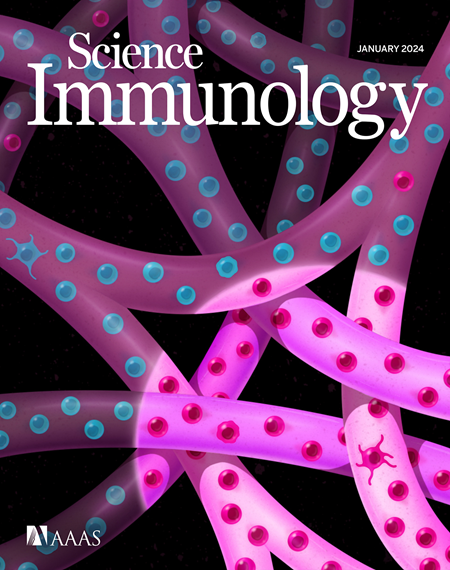种系靶向 SOSIP 三聚体免疫可诱导婴儿猕猴产生广泛中和抗体前体
IF 17.6
1区 医学
Q1 IMMUNOLOGY
引用次数: 0
摘要
青少年是一个不断增长的艾滋病病毒感染人群。从断奶到初次性行为之间的这段时间是艾滋病病毒感染的低风险窗口期,因此幼儿期是实施免疫方案的理想时期。由于诱导广泛中和抗体(bnAbs)对有效的艾滋病疫苗至关重要,我们的目标是评估 B 细胞系设计的 BnAb 艾滋病包膜 SOSIP(通过 gp120-gp41 之间的二硫键(命名为 "SOS")和残基 559 处的异亮氨酸到脯氨酸点突变(命名为 "IP")稳定的蛋白质)在生命早期诱导前体 CD4 结合位点(CD4bs)靶向 bnAbs 的能力。婴儿猕猴接受了基于婴儿 BG505 传播/创始病毒的 BG505 SOSIP 或 CD4bs 生殖系靶向 BG505 SOSIP GT1.1(每组 5 只)。虽然这两种策略都能诱导持久、高水平的血浆自体病毒中和反应,但只有 GT1.1 免疫的婴儿(5 人中 3 人)表现出类似 VRC01 的 CD4bs bnAb 前体发育。因此,使用bnAb品系设计的SOSIPs的多剂量免疫方案有望诱导早期B细胞应答,并有可能在初次性行为前成熟为保护性HIV bnAb。本文章由计算机程序翻译,如有差异,请以英文原文为准。
Immunization with germ line–targeting SOSIP trimers elicits broadly neutralizing antibody precursors in infant macaques
Adolescents are a growing population of people living with HIV. The period between weaning and sexual debut presents a low-risk window for HIV acquisition, making early childhood an ideal time for implementing an immunization regimen. Because the elicitation of broadly neutralizing antibodies (bnAbs) is critical for an effective HIV vaccine, our goal was to assess the ability of a bnAb B cell lineage–designed HIV envelope SOSIP (protein stabilized by a disulfide bond between gp120-gp41—named “SOS”—and an isoleucine-to-proline point mutation—named “IP”—at residue 559) to induce precursor CD4 binding site (CD4bs)–targeting bnAbs in early life. Infant rhesus macaques received either a BG505 SOSIP, based on the infant BG505 transmitted/founder virus, or the CD4bs germ line–targeting BG505 SOSIP GT1.1 (n = 5 per group). Although both strategies induced durable, high-magnitude plasma autologous virus neutralization responses, only GT1.1-immunized infants (n = 3 of 5) exhibited VRC01-like CD4bs bnAb precursor development. Thus, a multidose immunization regimen with bnAb lineage–designed SOSIPs shows promise for inducing early B cell responses with the potential to mature into protective HIV bnAbs before sexual debut.
求助全文
通过发布文献求助,成功后即可免费获取论文全文。
去求助
来源期刊

Science Immunology
Immunology and Microbiology-Immunology
CiteScore
32.90
自引率
2.00%
发文量
183
期刊介绍:
Science Immunology is a peer-reviewed journal that publishes original research articles in the field of immunology. The journal encourages the submission of research findings from all areas of immunology, including studies on innate and adaptive immunity, immune cell development and differentiation, immunogenomics, systems immunology, structural immunology, antigen presentation, immunometabolism, and mucosal immunology. Additionally, the journal covers research on immune contributions to health and disease, such as host defense, inflammation, cancer immunology, autoimmunity, allergy, transplantation, and immunodeficiency. Science Immunology maintains the same high-quality standard as other journals in the Science family and aims to facilitate understanding of the immune system by showcasing innovative advances in immunology research from all organisms and model systems, including humans.
 求助内容:
求助内容: 应助结果提醒方式:
应助结果提醒方式:


